Arsenal and Manchester United started the game separated by just one point; the former on 17, the latter 16. A win for either one would have sent them into the top four, putting them on course for the shared target of qualifying for the Champions League this season.
With Chelsea already on 32 points, a title challenge for either team looks incredibly unlikely even at this stage in the season.
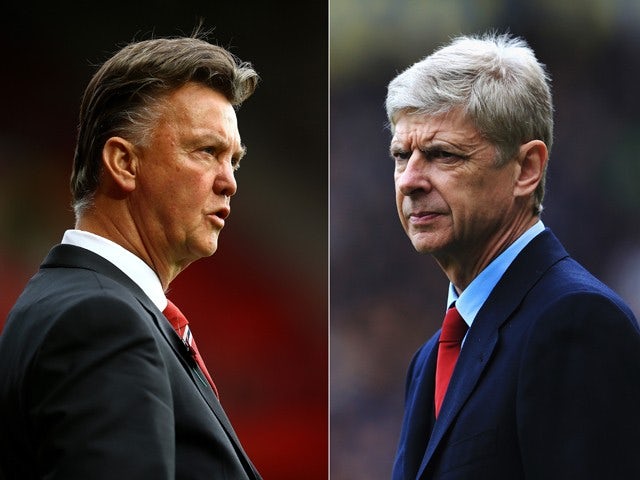 © Getty Images
© Getty Images
Arsene Wenger fielded a very attacking lineup on paper, filling his three central midfield roles with Mikel Arteta, Jack Wilshere and Aaron Ramsey - Mathieu Flamini relegated to the bench this time around. While he didn't start, Olivier Giroud made it into the matchday squad as a substitute following an extended layoff that has seen Danny Welbeck take his place... the former Man Utd striker earning more than a few plaudits in the process.
With Theo Walcott also out, Arsenal's front three consisted of Welbeck, Alex Oxlade-Chamberlain and Alexis Sanchez. Their back four of Kieran Gibbs, Per Mertesacker, Nacho Monreal and Callum Chambers, due to injuries to Laurent Koscielny and Mathieu Debuchy, virtually picked itself.
Man Utd's main concern going into the game was their own, dramatically extended injury list. Key players such as Radamel Falcao, Johnny Evans, Marcos Rojo, Phil Jones, Rafael and Daley Blind were all absent from the squad - although Ander Herrera was given the green light to appear on the bench.
Resultantly, Chris Smalling, Tyler Blackett and Paddy McNair started in a back three flanked by Antonia Valencia and Luke Shaw at full-back.
Michael Carrick and Marouane Fellaini occupied the central midfield roles, with Robin Van Persie joined by Angel Di Maria and Wayne Rooney to form an interchangeable, but narrow, front three. The system - a 3-5-2 that can easily switch into a 5-3-2 - was near identical to that used by Louis Van Gaal in his stunning Ajax team of 1994-95 and in his Dutch World Cup team of 2014.
Man Utd Paralysed By Arsenal's Directness
The sheer ferocity of Arsenal's attack over the opening 30 minutes left Man Utd's awkward-looking back three struggling to retain any semblance of disciplined shape or strategy. In a way not typically associated with a Wenger team, the London club's forward players took every opportunity to bomb forwards in straight lines in an attempt to unsettle the young defenders.
This pressure was applied both with and without the ball, giving Man Utd no time whatsoever to settle on the ball after winning possession back and forcing them into making risky passes and rushed clearances. Both of these courses of action resulted in Arsenal picking the ball back up in the attacking third with incredible consistency.
Man Utd tried to contain Arsenal's threat by sitting deeper and preventing the quick legs of Sanchez and Chamberlain getting in behind them. Unfortunately for them, the diversity of Arsenal's offence rendered this approach near-useless.
Through central areas Arsenal abandoned their usual policy of intricate passing into the box and opted for immediacy. Welbeck dropped slightly deeper than usual without possession, the idea being to pull Smalling out with him and create one-on-one situations for Sanchez and Chamberlain to take advantage of - the former against Paddy McNair, the latter Tyler Blackett.
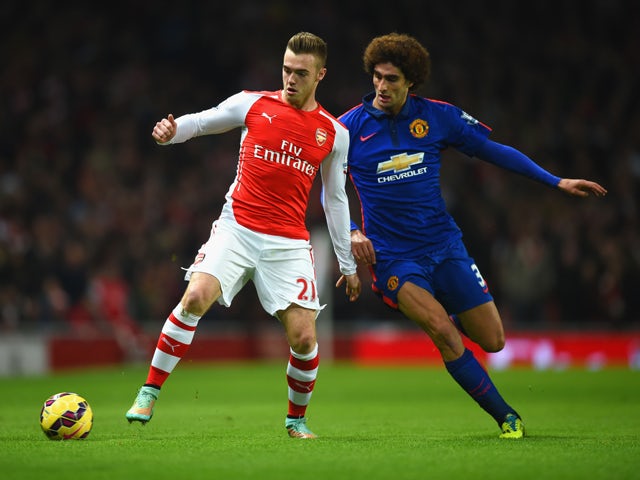 © Getty Images
© Getty Images
An altogether different approach was taken down the flanks, particularly down Arsenal's right-hand side. Wilshere teamed up brilliantly with Chamberlain and Chambers, the three of them tormenting Shaw and Blackett with unpredictable overlapping runs and crisp passing triangles.
This combination of directness through the middle and patience down the flanks prevented Man Utd's defence from ever settling into a reasoned rhythm. In terms of shape it meant their back three spent more time as a back five as wing backs Shaw and Valencia dropped ever deeper to help their struggling teammates.
One of the great advantages of Van Gaal's 3-5-2 formation is that it's so easy to quickly switch into a 5-3-2 when his team doesn't have possession. However, with Shaw and Valencia so concerned with offering cover, 5-3-2 became the core of Man Utd's approach for the majority of the first half.
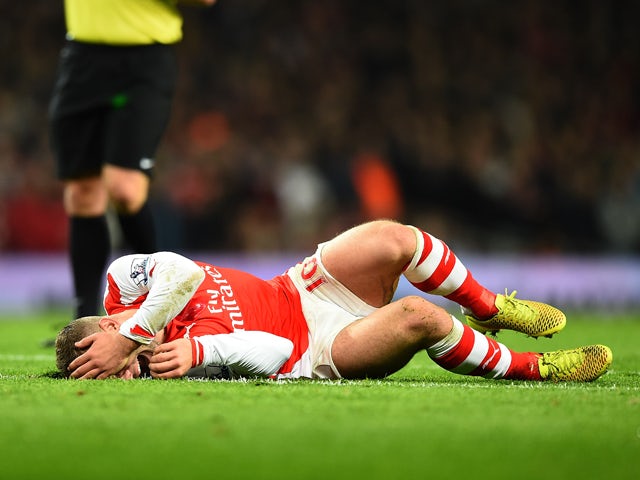 © Getty Images
© Getty Images
Arsenal's dominance was so significant that they managed nine shots, with five on target, in the opening half an hour. Man Utd, by comparison, managed just one attempt over the same period. The away side didn't register a single attempt on target in the first half.
It's quite amazing that Arsenal failed to score in the first half. Their chances were clear and obvious and Wenger will surely be shaking his head in confusion over the complete failure to make them count. On another day his team could have comfortably gone in at the break three or four goals up, but this most recent disappointment will only further harm the morale of a team seriously struggling to find consistent form.
David de Gea in Man Utd's goal was frequently all that stood between Arsenal and a glut of goals, the Spaniard undoubtedly man of the match. While many of Arsenal's shots were hit straight at him, not once did he spill the ball back into danger or fail to take complete charge of the situation. The goalkeeper's form this season makes him a sure-fire contender for the title of Man Utd's best player.
Man Utd: Familiar Shape, Unfamiliar Roles
The 3-5-2 / 5-3-2 might be a system familiar to Man Utd under the reign of Van Gaal, but the roles the participants played here were often unrecognisable. Impressively, Rooney has taken to playing a generally deeper role this season, but we've rarely seen him playing very much behind Di Maria.
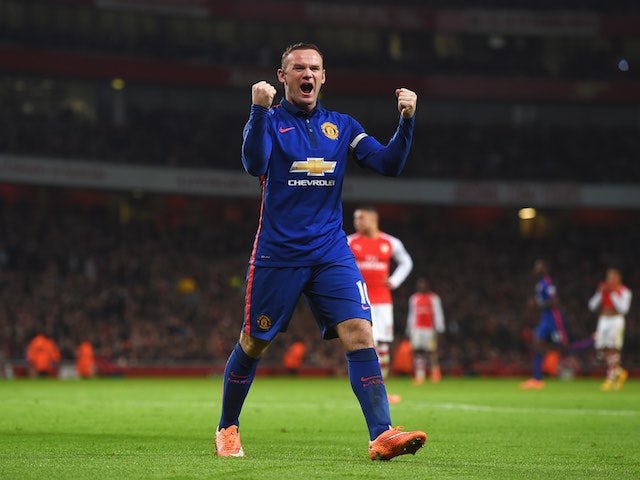 © Getty Images
© Getty Images
Rooney here played an orthodox number 10 role, his function to link the central midfield of Carrick and Fellaini to the forward line of Robin Van Persie and Di Maria. To say Rooney had little impact in the attack phase is an understatement... he was invisible.
With his wing backs forced to sit deeper than usual, Rooney had very little outlets open to him. Occasionally, Di Maria and Van Persie would drift into a wide area in order to horizontally stretch Arsenal's defence - but their impact remained muted given the lack of support available to them.
That would-be support was fully occupied with man-marking Arsenal's central core. Fellaini stuck to Ramsey, Rooney to Arteta and Carrick to Wilshere (later Santi Cazorla following Wilshere's injury). The degree to which the trio would man-mark is shown by how far they were willing to be drawn out of position. If Wilshere dropped back into defence to pick up the ball then Carrick would follow him, moving into a position beyond his own strikers.
This overloading of central areas added to the Man Utd's lack of width.
Such acts demonstrate perfectly just how in control of the match Arsenal were. Man Utd simply reacted to whatever Arsenal did, the game plan to make it as difficult as possible for the hosts to play through the midfield. Not once in the first half, and only extremely rarely in the second, did Man Utd abandon their disruption tactics for something more proactive.
While Van Gaal's team were successful in preventing Arsenal having much time on the ball in the middle third, Arteta and company overcame this by simply moving the play through them using one touch football. With the likes of Welbeck and Sanchez dropping slightly deeper frequently, there were still more red shirts around the centre circle than blue.
The major loser of this strategy was Van Persie, who was nothing more than a passenger for his entire performance. Whenever Man Utd won possession the team were so narrow that it was easy for Arsenal's makeshift defence to crowd the Dutch striker out of the action, even with Di Maria peeling off to try and artificially give him a free moment to move and receive the ball.
Man Utd might have won the game, but the way they went about it will not win them any admirers.
Arsenal's Cracks Become Disastrous Chasms
The Gunners might have dominated the game, but cracks in their armour became apparent after their ferocious first-half pace started to dampen after 35 minutes. It's only naturally for a team playing in such an exhaustive manner to pace themselves by easing off every now and again, but the way they lost control in the closing moments of the half will have sent alarm bells ringing.
A telling moment just before the first-half whistle saw Di Maria drift into a position on Man Utd's right. Picking up the ball he took a leaf out of Arsenal's book and drove straight at Gibbs, beating the left back with ease and working a shooting position on his favoured left foot. The shot missed, but this was the first warning sign of what was to come.
What followed was a complete reversal of prior events. For nearly 10 minutes Man Utd laid siege to Arsenal's goal, with shots leading to a series of corners that Arsenal showed no ability of being able to intelligently defend against. A golden opportunity from a corner wastefully squandered by Smalling was Arsenal's second major let-off in a half that they statistically dominated.
The second half started in the same way as the first, with Arsenal taking control and not giving Man Utd a moment on the ball. Their incompetence in front of goal also continued, however, De Gea stopped everything thrown at him.
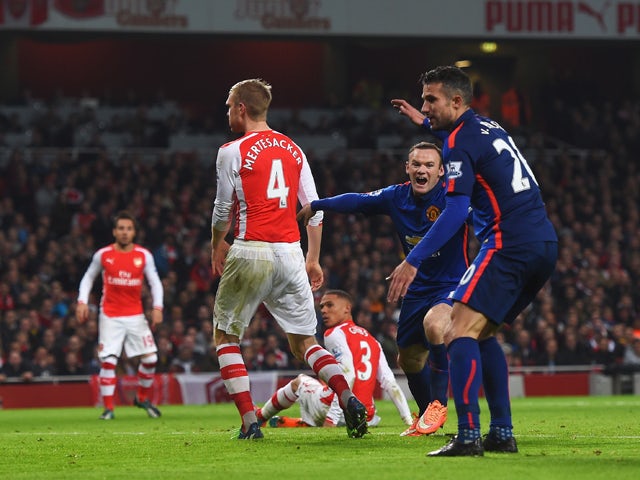 © Getty Images
© Getty Images
Such was their lack of a final product that when Man Utd eventually scored against the run of play it came with a sense of inevitability. The nature of the goal perfectly mirrored the situation.
With the Arsenal defence bunched up on their right-hand side to close down an advancing Ashley Young and his entourage of support runners, a no-man's land formed in the middle of Arsenal's box. Young was allowed to cross and sent the ball straight into this area, sending both Gibbs and goalkeeper Wojciech Szczesny darting towards it.
Their collision sent them both flying to the turf as an advancing Valencia picked up the loose ball just outside the 18-yard line. Santi Cazorla should have been picking up the Ecuadorian, but he was nowhere to be seen. The shot was scuffed horribly but deflected off of Gibbs and past a lost Szczesny.
Man Utd still hadn't managed a shot on target but found themselves 1-0 up. Arsenal had gifted them the goal, just as they'd gifted Man Utd a clean sheet up until that point. Man Utd failed to properly execute their attack, but Arsenal failed to do their job properly. A disaster all round, then, but one clear winner emerged from the calamity of errors.
Desperation Only Makes Things Worse
Arsenal reacted to the goal by throwing even more men forwards, in particular in wide areas. Gibbs and Chambers all but abandoned their defensive duties to join the attack, which by now included Olivier Giroud. With Giroud playing through the middle, Welbeck was pushed out to the left and Sanchez sat in behind them both. Further success followed, with shots continuing to come from all areas, but no breakthrough was found.
At this point Van Gaal instructed Carrick to play much more defensively, looking like a fourth centre-back at times. With Fellaini also dropping slightly deeper, Man Utd had the look of a coiled spring ready to explode on the counter-attack.
To aide in the counter-attack Van Persie was replaced by James Wilson, the young forward much more energetic when it came to tracking back and putting the Arsenal player in possession under pressure. Wilson might be an attacker by trade, but he was very much a defender here.
Both teams were playing eight outfield players in Man Utd's half; eight attackers versus eight defenders. Only Rooney and Di Maria stayed forward for Utd, marked by Monreal and Mertesacker. By sitting so deep Utd managed to create a huge gap between their defenders and the two attackers. That gap, to Arsenal's demise, was never properly filled.
Rooney's goal could have been predicted by someone who had never before watched football. Sanchez's attempted defence-splitting, showboating pass was blocked by Carrick and hungrily picked up by Fellaini who, without hesitation, knocked a simple long ball to the feet of Di Maria.
Di Maria and Rooney versus the slow Mertesacker and a Monreal playing out of position is not an equal match-up. A simple ball into the feet of Rooney allowed him to progress unchallenged and coolly chip the keeper to make it 2-0.
To their credit, with only five minutes of regular time to play, Arsenal continued to press forward. Understandably, however, they looked less enthusiastic about doing so.
Giroud's goal in stoppage time was certainly one of the more difficult chances of the game, further bringing into question his team's inability to make good on earlier opportunities. Four minutes remained to get an equaliser, but a prolonged, silly scuffle between multiple players in Arsenal's half all but ran down the clock.
Wenger's side won the beauty contest; their crisp passing, frightening pace and ability to pile on sustained pressure creating a show of free-flowing movement that was often mesmerising in its detail and complexity.
Van Gaal's team, however, highlighted just how bankable a pragmatic approach can be. Without a doubt Man Utd were lucky not to concede at least a couple of goals within normal time, but once they went ahead they never looked like losing. They put all of their effort into a contain-and-counter-attacking game and it worked. It was an ugly, ugly victory, but a victory nonetheless.
No Data Analysis info








